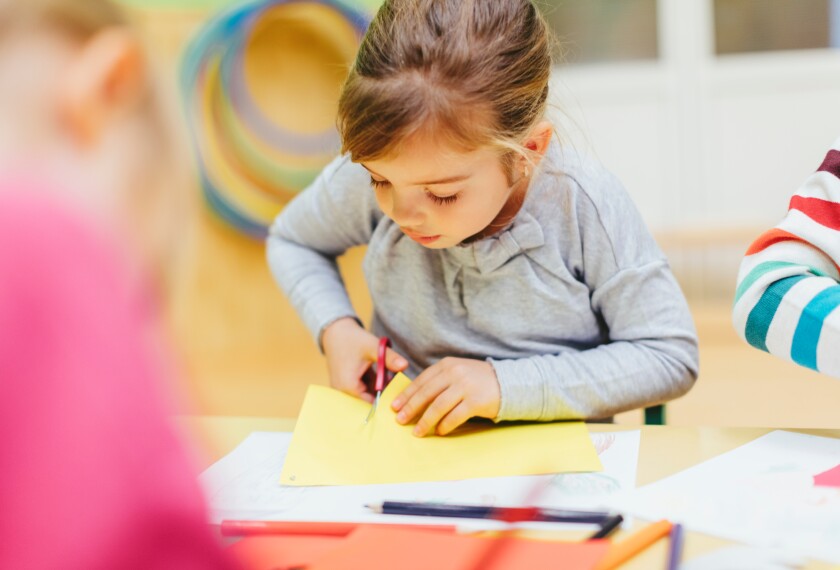Young English-language learners still developing oral and literacy skills in their home languages benefit most from early-childhood programs that regularly expose them to both languages.
That’s the conclusion of a new federally funded analysis of the large, and growing, population of dual-language learners, ranging from birth to 5, who are already enrolled in or headed for early-care and early-childhood-education programs.
By 2020, preschool-age children in the United States who are exposed to or use a language other than English at home will outnumber their monolingual English-speaking peers, according to some estimates.
The analysis, released last week, also emphasizes that dual-language learners differ from their monolingual peers in how they develop language skills, but it cautions that those differences should not be assumed by caregivers and teachers to be academic risk factors.
Young dual-language learners, who are using two separate language systems, will take longer to reach proficiency in both languages than their peers learning only one, the report says. But ultimately, it says, they will reach English fluency faster than they would otherwise if their first language is also supported in the classroom.
“Their development is different,” said Dina C. Castro, one of the report’s lead authors. “It’s not better, it’s not worse, just different.”
Too often, Ms. Castro said, dual-language learners’ school readiness gaps in kindergarten are assumed to be language-related, rather than stemming from other factors, such as poverty.
Numerous studies have also found that young children learning two languages demonstrate key school-readiness factors: strong social-emotional development and “executive function” skills, such as listening and following directions, the review concludes.
‘Unequivocal’ Findings
Conducted by Ms. Castro and other researchers affiliated with the Center for Early Care and 91��Ƭ����Ƶ Research—Dual-Language Learners, the analysis is a summary of more than 200 studies, including research done at the center itself. The studies shed light on how dual-language environments and bilingualism affect language and cognitive development in young children and how early-childhood practices can hinder or help dual-language learners.
The center, based at the University of North Carolina at Chapel Hill, started its research work in 2009 and is financed through the U.S. Department of Health and Human Services, the agency that oversees the Head Start and Early Head Start programs for poor children.” The recommendations are crystal clear and unequivocal that supporting the home language, as well as English, is the best thing for young dual-language learners,” said Karen N. Nemeth, an early-childhood and dual-language specialist and a private consultant in Newtown, Pa., who was not involved in the analysis.
“It tells us that there are no other good options for these children, and anyone who chooses to run a program for birth to 5 that doesn’t offer home-language support is doing them a disservice.”
Many existing dual-language approaches are found in Head Start and Early Head Start, which established standards that require providers to address the needs of dual-language learners and “principles” that direct Head Start programs to develop children’s first languages, as well as English.
Home-Language Support
Some state-provided early-learning programs—the one in Illinois, for example—also require development of home languages in addition to English.
Overall, however, few early-childhood programs feature “intentional” home-language instruction and support, the researchers say. But they argue that the “most important aspect” of effective early-childhood education for dual-language learners is using the home language of young children, in addition to English.
When English-language development is the sole emphasis, they write, a child’s first-language skills often decline, hampering progress toward English-language proficiency later.
Linda M. Espinosa, another co-author and a retired professor of early-childhood education at the University of Missouri-Columbia who has written extensively on young dual-language learners, said programs in early-childhood settings “vary enormously.” Many classrooms, for example, don’t have fully bilingual teachers, she said, but still offer frequent opportunities for children to hear, speak, and interact in their first language.
Bringing parents and community volunteers who speak the home languages into classrooms to converse with children and read to them is one way of providing support, Ms. Espinosa said. Providing books and music and presenting other classroom materials in the home language is another way.
The report recommends making dual language in early-care and early-education programs more widely available. To do that, the authors write, will require federal and state policymakers to support more training programs for early-childhood educators to bolster the literacy and language development of young dual-language learners.
The authors also call for tighter coordination between early-childhood programs and K-12 school systems, so that the early dual-language skills aren’t lost once children move to kindergarten and beyond.
Eugene E. García, a professor emeritus of education at Arizona State University in Tempe and a lead author of the analysis, said the research shows clearly that language-development problems for young English-learners crop up when support for their home language is not provided.
“It’s counterintuitive. But building the literacy and language skills in the first language helps students build their proficiency skills in English,” said Mr. García, who headed the office of bilingual education in the U.S. Department of 91��Ƭ����Ƶ under President Bill Clinton.
That conclusion is still debated in some circles outside of academia, and teaching children in any language other than English remains controversial. The focus of federal education policy for K-12 English-learners for years has been on English-language acquisition, not on developing first languages alongside English to become fully bilingual and biliterate.
Mr. García thinks there is potential to shift discussions in federal education policy to the merits of dual-language instruction for ELLs in K-12.
“We haven’t made much headway in reducing the achievement gaps for English-learners” under current policy, he said.





